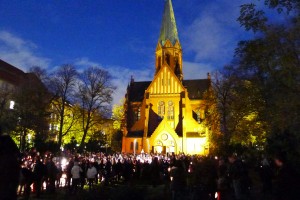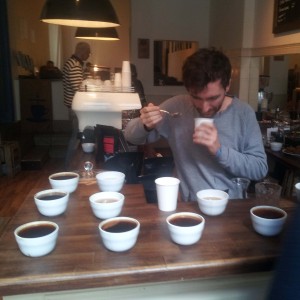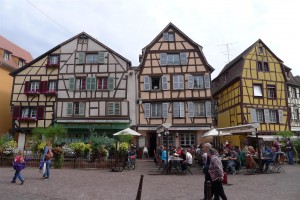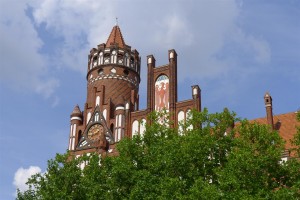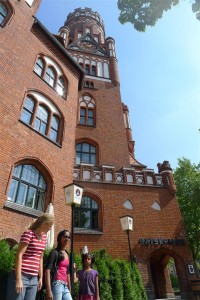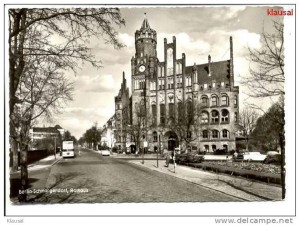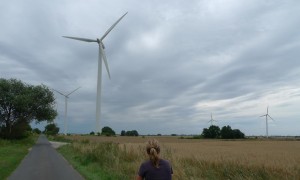On the evening of November 11, Mamta took to the streets to celebrate Saint Martin’s Day — Martinstag — with her cousins. Prior to the day, I was not familiar with Saint Martin or the celebration. When I asked my sister-in-law Doreen about Saint Martin, she gave me a one-sentence summary: “He was a Roman soldier who shared his cloak — by cutting it in half — with a beggar on a cold winter evening.” It turns out that’s not all he did, but that act of generosity is re-enacted annually in Saint Martin’s Day celebrations across Germany.
Author Archives: andrew@andrewdey.com
The Cupping
I recently came across an article that likened certain sections of Berlin (“Berlyn”) to Brooklyn, NY. Apparently there is a good deal of cross-pollination occurring between these two urban hotspots. The other day I was invited by a friend to attend a coffee tasting in Penzlauer Berg, a neighborhood that has been compared to Brooklyn’s Park Slope. Or Williamsburg, I thought as I entered the shrine to coffee known as Cafe ck.
The coffee aroma in the cozy cafe was compelling. Soul music — Mavis Staples, James Brown — spun on a turntable tucked beneath the rear counter. A small shelf displayed trophies and plaques from various coffee-related competitions. The two bearded, twenty-something baristas behind the counter executed their work with earnest precision.
This was my first coffee tasting, or “cupping,” as I learned to call it. The eight participants included several other neophytes. We could tell the veteran cuppers: they had brought small notebooks in which to record their tasting notes.
Last Night in the Subway
Last night Mamta and I came home late from her cousin Jonas’s birthday party. It took me a while to peel Mamta away from the movie — How to Train Your Dragon — that she and the other kids were watching. Annette had gone home ahead of us by bike.
Mamta rode her scooter to the subway station and I jogged alongside her. As we descended the stairs, we saw two workers in red overalls operating commercial floor scrubbing equipment by the ticket machine. They were just finishing cleaning the tile floor of the subway platform. The damp tiles glistened, and the scent of detergent hung in the air.
Mamta and I jostled for dibs on the ticket machine, and I then grabbed her scooter and rolled down the brightly-lit platform. We could see from the signboard above the platform that our train would be arriving in three minutes. We were the only people waiting for the train.
I started scootering around one of the columns in the middle of the platform — and wiped out on the slick tiles. I sheepishly arose, and Mamta took over the scooter. We ended up chasing each other in circles around the column. When we heard the train approaching, we stopped and folded up the scooter.
“Hey,” I heard a voice call out to us as we headed for the train. It was one of the workers we had seen operating the cleaning equipment. A young guy. Serious. “You shouldn’t be fooling around like that on the subway platform. It’s not a playground.”
I was — the word in German is “verblüfft.” A combination of taken aback, amazed and bewildered. I was also touched by his concern, and slightly amused. I didn’t consider what Mamta and I had been doing to be at all risky or dangerous. On the other hand, accidents do happen.
“Ja, Sie haben Recht,” I replied. You’re right. With appreciation for Germany’s culture of order, I hustled to join Mamta on the train.
Energetische Sanierung
[A version of this post was published at GreenBuildingAdvisor.com on 7Jan14]
I don’t know whether there are any building geeks reading this blog, but if so, here’s a post for them. I am including more photos of insulation details than a normal person would find interesting.
 A few weeks ago while biking back from a visit to Rani’s high school, I stopped at a job site that had previously caught my eye. Although the buildings were shrouded in the usual scaffolding and screening, I could tell that the work involved “energetische sanierung,” or energy retrofitting.
A few weeks ago while biking back from a visit to Rani’s high school, I stopped at a job site that had previously caught my eye. Although the buildings were shrouded in the usual scaffolding and screening, I could tell that the work involved “energetische sanierung,” or energy retrofitting.
Two workers were installing rigid foam around newly-installed windows. I asked if I could take some photos, explaining that I was a project manager from the US, and interested in energy efficiency. As often happens in this situation, their initial reticence gave way to a quick tour of the work and informative answers to my questions.
While the materials and techniques used on this project are run-of-the-mill for Germany, and may be of limited applicability to projects in New England, I like to think that sharing them might contribute to innovative thinking in someone, somewhere. The rest of this post contains photos and notes about the insulating skin being installed on the building.
Halloween
Our hometown of Walpole, New Hampshire sets a high bar when it comes to Halloween. Many people decorate their houses, some of the parents dress up, and the village is swarming with elaborately-costumed kids. Typically I will don a simple costume and man our front porch with a mechanical skeleton that declares: “Do not be afraid!” Most kids aren’t. One year we had so many trick-or-treaters that I ran out of candy, and had to replenish our bowl with treats that Mamta had gotten at other houses. While I am meeting and greeting kids at the front door, Annette hosts our adult guests back in our kitchen, treating them to mulled wine and Hungarian goulash (ghoulash?) soup.
I could tell from the lack of build-up that Halloween was not going to amount to much here in Berlin. A week ago I saw in our local office supply store a small display of plastic pumpkins and miscellaneous spooky trinkets. When I returned there today to buy the one witch hat I had seen, the entire display was gone, replaced by Christmas decorations. But it’s only Halloween!
Swimming Lessons with Jürgen
Yesterday Mamta swam for ten minutes with her clothes on. Her pajamas, actually. No, she hadn’t sleep-walked to the Grunewald See. She was at her weekly swimming lesson with Jürgen, swimming coach to the stars.
We found Jürgen’s swim class through Annette’s sister Doreen. Two of Doreen’s children were already progressing under his tutelage. Annette took Mamta to her first class about six weeks ago.
“Ja,” said Jürgen with unvarnished disdain after first watching Mamta swim, “she clearly hasn’t been taking lessons with Jürgen!”
Colmar
Last week during our daughters’ fall vacation, we visited the French town of Colmar with Annette’s family. I am all for making old buildings more energy efficient, but being in Colmar reminded me that some buildings with poor energy efficiency are “good enough” as-is.
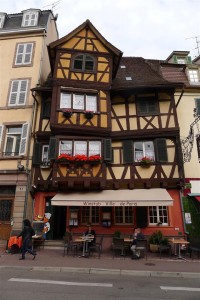 Colmar is located in the Alsace region of France, but its culture is a mix of French and German elements. From the late 1800’s to the mid 1900’s, France and Germany exchanged control of the region four times. Places with names like “Kayserberg“ and “Herrlisheim-prés-Colmar“ reflect that tangled history.
Colmar is located in the Alsace region of France, but its culture is a mix of French and German elements. From the late 1800’s to the mid 1900’s, France and Germany exchanged control of the region four times. Places with names like “Kayserberg“ and “Herrlisheim-prés-Colmar“ reflect that tangled history.
Most striking to me was Colmar’s “Vieux Ville” — the historic town center. Annette and I pay attention to buildings, and we are used to seeing a handful of artfully-restored half-timbered houses in the centers of European towns. But Colmar has what must be hundreds of lovely tipped, sagging, bowed, and angled-but-still-standing half-timbered houses. Neither Annette nor I could recall being in a place where so many half-timbered houses have been so well preserved.
Open Built Sidewalks
Open Building is the most compelling framework for envisioning building construction that I have come across. Ideas that were originally formulated by the Dutch architect John Habraken have been further developed by others, including Stewart Brand in the book How Buildings Learn, and Tedd Benson and his team at Bensonwood Homes. Back in 2006 while working at Bensonwood, I wrote an article about Open Building for Fine Homebuilding Magazine.
One of the essential tenets of Open Building is that buildings should be flexible and adaptable, because their functions change over time, as do the environmental conditions in which they exist. Buildings are seen as being made up of layers that have distinct lifespans and differing needs for access and modification. For example, the structure of a building should be long-lasting and well-protected, and not entangled with layers such as the mechanical and electrical systems that require more frequent access, or the insulating skin that should be continuous.
Traveling around Berlin, I have been thinking about Open Building in the context of underground construction. Continue reading
Schmargendorf
I can’t say that I was enthusiastic about living in Schmargendorf when Annette first mentioned that her online searching had turned up an apartment there. It’s not that I knew anything about the area, but the name made me think of Schmaltz, the solidified chicken fat that is enjoyed spread thickly on slices of brown bread. My interest in the area was further tempered when I saw on a map how far it is from the more centrally-located, hipper locales like Kreuzberg, Mitte and Prenzlauer Berg. But the location looked like it would work well for Rani’s school, and it is close to the Grunewald park. The apartment itself is wonderful, and — the clincher, in Rani’s opinion — the kitchen cabinets are bright red.
Outside the center of the city, Berlin feels to me like a tapestry of towns. As the city expanded over time, it absorbed what had been outlying villages with their own town centers and neighborhoods. I read that “Schmargendorf” was first recorded as the name of our area in 1354. Through the 19th century, Schmargendorf was a small farming village on the outskirts of Berlin. By the turn of that century, the village had its own local administration, and in 1920 it officially became incorporated as part of greater Berlin.
This area’s historic town hall or “Rathaus” is adjacent to Mamta’s school, one block over from our apartment. It was built in the year 1900, in a style that is described as “Brick Gothic, with elements of Art Deco.” The building survived WWII largely intact, although the explosion of a bomb nearby blew out the original stained-glass windows.
The Rathaus includes a restaurant in the cellar called — what else? — the Ratskeller. In this case, Rat refers to a council or advisory board — like our hometown of Walpole’s governing selectboard — rather than to a rodent.
Luxury Power?
Note: on 15Oct13, a version of this post was run as a guest blog at GreenBuildingAdvisor.com
Der Spiegel is a weekly German news magazine whose gravitas I might have placed somewhere between Newsweek and The Economist. However, a recent cover story about Germany’s “Energiewende” did not strike me as particularly impartial or objective.
Energiewende literally translates as “Energy Turn,” but it is more typically expressed as “Energy Transition,” “Energy Transformation,” or “Energy Revolution.” The term refers to the German government’s 40-year plan to restructure its energy systems to achieve specific energy-related and carbon-reduction goals.
These goals include:
-
Reducing greenhouse gas emissions by 40 percent by 2020, and by 80 percent by 2050 (as compared to 1990 levels)
-
Phasing out the use of nuclear power by 2022
-
Reducing primary energy consumption by 20 percent by 2020, and 50 percent by 2050 (compared to 2008 levels)
-
Expanding the use of electric vehicles: 1 million by 2020, and 5 million by 2030
-
Increasing the percentage of energy from renewable sources to 18 percent by 2020 and 60 percent by 2050
A serious attempt at achieving these goals will require increasing the energy efficiency of all market sectors (housing, transportation, industry, etc.), dramatically expanding the use of renewable energy, and shifting energy-related attitudes and behaviors to a new paradigm.
One of my motivations for spending a year in Germany was to learn more about the Energiewende — to dig more deeply into the program specifics, and to find out how it is working.

